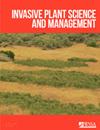Indaziflam reduces downy brome (Bromus tectorum) density and cover five years after treatment in sagebrush-grasslands with no impact on perennial grass cover
IF 1.3
4区 生物学
Q3 PLANT SCIENCES
引用次数: 2
Abstract
Abstract The invasive annual grass downy brome (Bromus tectorum L.) is a critical threat to the semiarid shrublands that characterize western North America. More abundant fine fuel after invasion typically increases fire frequency in plant communities adapted to relatively infrequent burning, reducing the likelihood of native plant persistence. Currently, imazapic is most often used to manage B. tectorum, but reinvasion from the seedbank after treatment is common. Indaziflam is a newer herbicide recently labeled for use in rangelands grazed by livestock, and many research trials have demonstrated its ability to deplete invasive annual grass seedbanks. We evaluated the effectiveness of indaziflam and imazapic for reducing B. tectorum density and cover over a period of approximately 5 yr (57 mo after treatment [MAT]) at two invaded sagebrush-grassland sites near Pinedale, WY. Treatments included three different indaziflam rates (51, 73, and 102 g ai ha–1) and one imazapic rate (123 g ai ha–1), and these treatments were reapplied to half of each plot at 45 MAT to evaluate the effects of two sequential applications. We also measured perennial grass cover, because positive perennial grass responses were observed after release from B. tectorum competition in other studies, and perennial grasses may provide resistance to B. tectorum reinvasion. Intermediate and high indaziflam rates (73 and 102 g ha–1, respectively) reduced B. tectorum cover and density at 45 MAT, and perennial grass cover responded positively to some treatments, mostly early in the study (≤33 MAT). Imazapic reduced B. tectorum initially, but did not affect density or cover at either site beyond 21 MAT. Reapplication did not substantially improve B. tectorum control at 57 MAT in plots treated with intermediate and high indaziflam rates, suggesting that long-term control with a single indaziflam treatment may be possible in some cases.Indaziflam在山艾树草原处理五年后降低了绒毛雀麦(Bromus tectorum)的密度和覆盖率,对多年生草地覆盖率没有影响
摘要入侵的一年生草本绒毛雀麦(Bromus tectorum L.)对北美西部半干旱灌木林构成了严重威胁。入侵后更丰富的细燃料通常会增加植物群落的火灾频率,以适应相对不频繁的燃烧,从而降低本地植物持续存在的可能性。目前,伊玛扎匹克最常用于管理B.tectorum,但处理后从种子库重新侵入是常见的。Indaziflam是一种新的除草剂,最近被标记用于牲畜放牧的牧场,许多研究试验已经证明它有能力耗尽入侵的一年生草种子库。我们在大约5年(治疗后57个月[MAT])的时间里,在怀俄明州派恩代尔附近的两个被入侵的山艾树草原地点,评估了吲唑仑和伊玛扎匹克降低B.tectorum密度和覆盖率的有效性。治疗包括三种不同的吲唑酮率(51、73和102 g ai ha–1)和一种伊玛扎吡率(123 g ai ha-1),并在45MAT将这些处理重新应用于每个地块的一半,以评估两次连续应用的效果。我们还测量了多年生草本植物的覆盖率,因为在其他研究中,在从B.tectorum竞争中释放后,观察到了积极的多年生草本植物反应,并且多年生草本植物可能对B.tectorium再入侵具有抵抗力。在45 MAT时,中等和高吲唑菌率(分别为73和102 g ha–1)降低了覆盖层和密度,多年生草覆盖层对一些处理有积极反应,主要是在研究早期(≤33 MAT)。Imazapic最初减少了盖氏芽孢杆菌,但在超过21 MAT时不会影响任何一个部位的密度或覆盖率。在用中高吲唑仑治疗的地块中,在57 MAT时再次应用并没有显著改善盖氏芽孢菌的控制,这表明在某些情况下,单次吲唑普兰治疗可能会进行长期控制。
本文章由计算机程序翻译,如有差异,请以英文原文为准。
求助全文
约1分钟内获得全文
求助全文
来源期刊

Invasive Plant Science and Management
PLANT SCIENCES-
CiteScore
2.20
自引率
9.10%
发文量
24
审稿时长
6-12 weeks
期刊介绍:
Invasive Plant Science and Management (IPSM) is an online peer-reviewed journal focusing on fundamental and applied research on invasive plant biology, ecology, management, and restoration of invaded non-crop areas, and on other aspects relevant to invasive species, including educational activities and policy issues. Topics include the biology and ecology of invasive plants in rangeland, prairie, pasture, wildland, forestry, riparian, wetland, aquatic, recreational, rights-of-ways, and other non-crop (parks, preserves, natural areas) settings; genetics of invasive plants; social, ecological, and economic impacts of invasive plants and their management; design, efficacy, and integration of control tools; land restoration and rehabilitation; effects of management on soil, air, water, and wildlife; education, extension, and outreach methods and resources; technology and product reports; mapping and remote sensing, inventory and monitoring; technology transfer tools; case study reports; and regulatory issues.
 求助内容:
求助内容: 应助结果提醒方式:
应助结果提醒方式:


